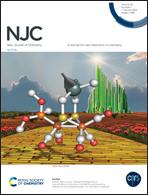Self-healing hydrogel sensors with multiple shape memory properties for human motion monitoring†
Abstract
Shape memory hydrogels offer new opportunities for the development of smart wearables due to their intelligent responsiveness. In this study, a self-healing hydrogel with multiple shape memory properties was prepared via one-step polymerization. The synergy of dynamic electrostatic interactions and imine bonds afforded a physically and chemically dual-crosslinked hydrogel with high stretchability (maximum strain of 556%), tensile fracture strength (63 kPa), and self-healing properties (99% healing efficiency at 60 °C within 4 h). Through the reversible construction of physical crosslinking points, the temporary shape of the hydrogel was fixed by two different types of stimuli, pH and metal ions (Ag+, Zn2+, etc.), with the shortest shape fixation time of 15 s. Furthermore, the hydrogel was used to fabricate resistive strain sensors and capacitive pressure sensors, and both types displayed high sensitivity, stability, and cyclability. The sensors could detect various types of human body movement, such as finger bending, swallowing, and pulse, indicating a promising future in smart wearables and healthcare monitoring.



 Please wait while we load your content...
Please wait while we load your content...